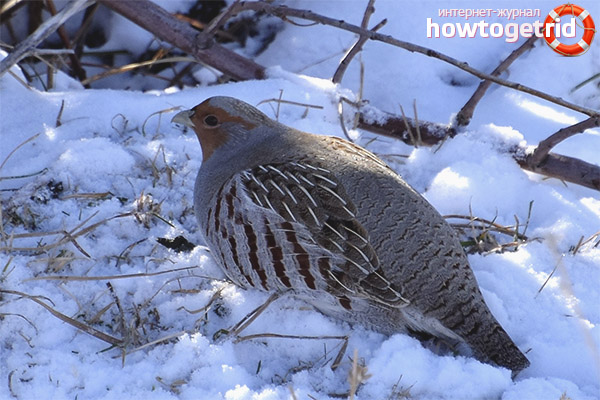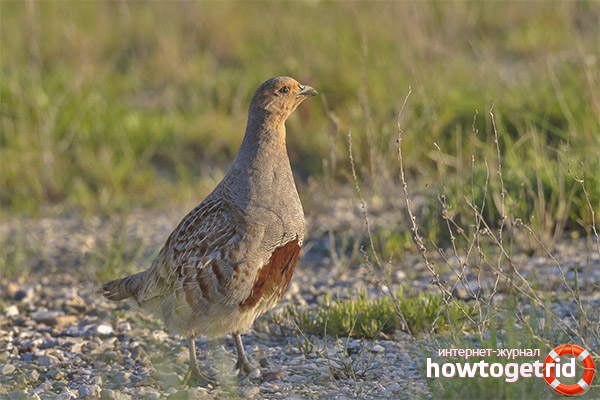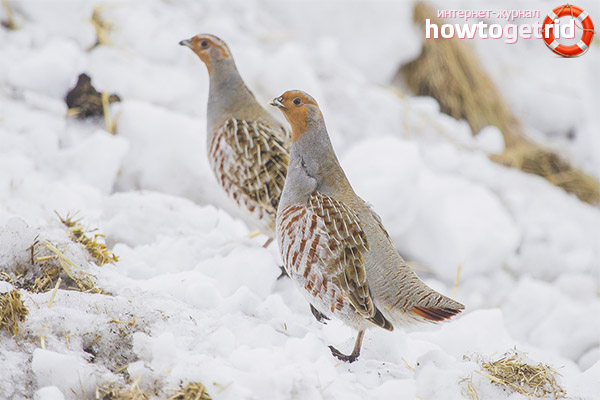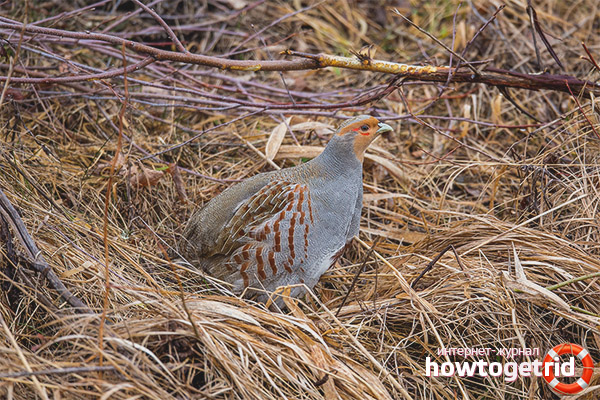The content of the article
The gray partridge is a representative of the order of galliformes, the pheasant family. Ornithologists believe that this species formed about two and a half million years ago. Partridge was a good nutritional option for an ancient person. Her meat was appreciated and considered a treat. It was the taste qualities that made the partridge attractive for human hunting.
Partridge - how to recognize it?
A gray partridge is often called a wild chicken. The name is associated with both appearance and consonant squawking with poultry. Its head is small in size and painted in ocher color. The breast has lighter shades - from yellow to light brown.
The bird has a rounded gray shape of the front part and there is a dark pattern on the back. On the abdomen, you can see an ornament resembling a horseshoe, and partridge sides are decorated with brown stripes. An interesting fact: you will not see a pattern in the form of a horseshoe in young individuals, because it appears in sexually mature females ready for breeding. The tail, like the muzzle, has a reddish tint, and the legs and beak are almost dark. Partridge is characterized by a small size of 25-35 centimeters. Her weight reaches half a kilogram, and she can spread wings by as much as 50 centimeters.
If the partridge is a young individual, then it can be recognized by the color of the stripes that are located along the body. Their color is dark gray. You can determine the male or female by the shade of plumage. The males look brighter, and the females give a red plumage on their tail. Partridges can also be recognized by the sounds they make. Their chirping is the croaking of chickens, and the sounds of males resemble the crowing of domestic roosters.
Partridges almost do not fly, and their favorite place is on the earth, among dense vegetation. It is in the grass that she can feel most secure. Due to its strong legs, it can quickly move among dense stands. In case of danger, the bird can take advantage of the wings, but this is extremely rare.
Where do the birds live?
The favorite places for partridges for settlement are steppes, fields, plains, which have dense vegetation, the presence of shrubs and ravines. Often, partridges choose potatoes, oats or millet, which are grown on farms, as a treat, so the birds are frequent guests there. In the fall, partridges move to forest belts. Partridges can also be found in deforestation sites, on plains, or in mountainous areas.
Gray partridges do not like to change habitats, therefore they live on the same territory almost all their lives. Partridge habitat can be changed only in case of lack of food. But a change of residence wags birds very poorly. The search for new housing makes them fearful. Partridges live in flocks throughout the fall and winter, and in the summer they form pairs for breeding and nests each pair on its site.
Partridge species
Partridges are divided into three types:
- Gray.
- Bearded.
- Central Asian
The gray and bearded partridges are very similar, often these species are combined. By the way, they are most in demand among hunters, so their number is rapidly decreasing. The Central Asian partridge lives in Tibet.Her color is significantly different from her brothers. Head with white plumage and two black spots. The bird's chest is strewn with black stripes. This species reproduces well and their number is stable.
Partridge feeding
Partridges consume plant foods: inflorescences, roots, seeds, and beetles, caterpillars, and larvae may also be included in their diet. As described above, their sturdy paws allow you to dig the ground and earn your own food.
The most difficult period for partridges is winter. It is very difficult to find food under a thick layer of snow. This is where the transition from doubles to flocks takes place. Partridge settles near a person, next to the fields where you can enjoy the grains from the harvested crop.
Young partridges prefer insects. They feed in the early morning, as they hide from day-to-day danger in the thick grass day and evening.
Breeding
The breeding season in birds begins in the month of April-May. If a couple has formed, then they will be together for the entire period of their life. To entice the female, the male dissolves its plumage and begins to perform a mating dance, while making sounds similar to crowing. If the female pays attention to the male, then she becomes his second half.
Then the couple begins to twist their nest. The place must be protected from evil eyes. It is located in tall grass near shrubs. The nest is created in the recess, where plants and soft grass are carefully laid out. Its width reaches 20 centimeters, and its depth is about 7 centimeters. Insulate their nest with tree leaves, down, grass and feathers. Partridge gray females are quite prolific and carry 10 to 25 eggs at a time. Eggs are gray-brown in color with a pointed end. Hatching lasts 23 days.
The appearance of chicks occurs in early June. Hatched chicks adapt quite easily and the survival rate is very high. From the first day, the chicks begin to become active. During adulthood, the male and female jointly grow them. The head of the family can both hatch eggs and defend his children from enemies. There are frequent cases when the male dies in the battle with the enemy, saving his offspring.
The partridge turns from a chick to an adult after 4 months, grows to the size of an adult bird already 1.5 months after birth, and at two weeks of age it can fly at decent distances. The ability to reproduce appears in 12 months.
If one of the parents dies, then the family moves to the second, if the chicks remain orphans, then another family takes care of them.
Who are the partridges afraid of?
Enemies for partridges in natural conditions are:
- Birds of prey: kite, owl, gyrfalcon.
- Predatory animals of small and medium sizes: fox, ferret, arctic fox.
- Animals that live near humans: rat, cat.
Partridges can live 10 years if they are not in danger, but in the environment of natural habitat they are a tasty treat for animal predators, therefore their life span varies around 4-5 years.
Interesting bird behavior facts

The steppe hens are most active in the morning and evening. It is related to the search for food. Partridges do not like to fly, therefore they behave very quietly and carefully so as not to fall into the eyes of a predator. If the threat of attack is close, the bird takes off low, travels a few hundred meters, and then skillfully hides in the dense grass.
When it begins to get colder, the steppe hens are grouped into several individuals (5-10), choose in-depth places hidden from the wind - and thus spend the night. When a lot of snow falls, partridges make a depression in the snow and spend the night there, warming each other. A gray partridge can also dig a tunnel in the snow with a recess resembling a separate room in which it safely spends the night.
Human breeding
Partridge farming on the farm has become quite profitable and popular. To do this, at home it is necessary to equip a bird's yard. It is necessary to avoid cells, because Partridge - a free bird, accustomed to space. But we must remember that she is not a chicken and can perfectly fly through an open aviary.
In order for the bird to breed, you need to take care of sufficient lighting of its habitat. Also, the place should be as close as possible to the natural environment, i.e. the presence of branches, shrubs is welcome.
Take care of the formation of pairs, as in natural conditions. If the female is nervous, pecks the male - then it should be replaced.
Under the conditions of living, eating and breeding partridges, growing them at home can bring you considerable profit, since poultry meat contains a small amount of carbohydrates and is in demand in the restaurant business.
Partridge Gray
Partridge is a very attractive food for many predators and often it does not live even half of its life, so you need to take care of it and save this species. This species is not listed in the Red Book, as it is believed that because of their unique ability to lay a large number of eggs at a time, they can restore their numbers themselves.
This article has already described that gray partridges are rapidly losing their numbers in the animal kingdom. Even a flock of 35 individuals with their fertility cannot provide a constant number of its members.
Measures that are used as protection by partridge gray:
- Hunting steppe chickens is prohibited.
- When harvesting, ears are left untouched in the territory bordering shrubs and ravines.
- Stray animals (rats) are caught.
- Use harmless fertilizers.
From time immemorial, the gray partridge has been a food for humans and, despite thousands of years, this species has survived, and to this day lives in our neighborhood. Only a person can have a positive impact on the conservation of the abundance of this species.
Video: Gray Partridge (Perdix perdix)












Submit